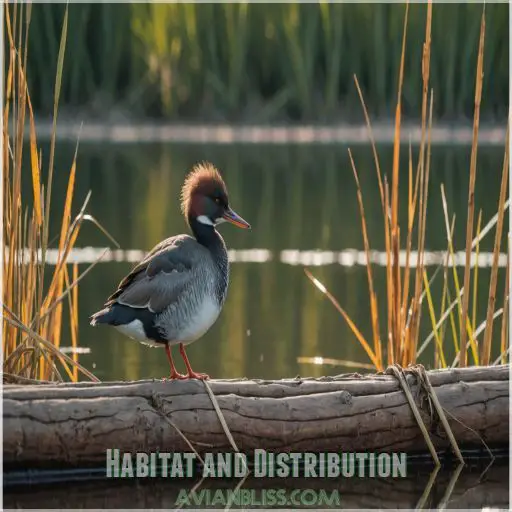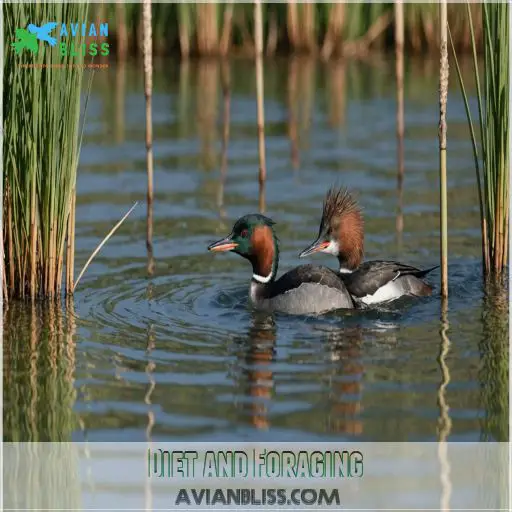This site is supported by our readers. We may earn a commission, at no cost to you, if you purchase through links.

These ducks aren’t just pretty faces; they’re ace fishers with long, serrated red bills perfect for catching aquatic delights.
Known for their preference for clear, freshwater habitats, they gallivant south as seasons change.
Got a soft spot for curious courtship rituals? You’re in luck! Their playful displays are a sight to behold. Ready to dive deeper into their world? There’s plenty more to learn!
Table Of Contents
- Key Takeaways
- Common Merganser Identification
- Habitat and Distribution
- Behavior and Social Structure
- Diet and Foraging
- Nesting and Breeding
- Conservation Status and Threats
- Similar Species and Lookalikes
- Interesting Facts and Trivia
- Frequently Asked Questions (FAQs)
- Are Common Mergansers rare?
- What is an interesting fact about the Common Merganser?
- Is a Common Merganser a loon?
- Is a merganser a mallard?
- What are the predators of Common Mergansers?
- How do Common Mergansers communicate with each other?
- What is the role of males during incubation?
- Can Common Mergansers adapt to urban environments?
- Do Common Mergansers suffer from any specific diseases?
- Conclusion
Key Takeaways
- You’ll spot Common Mergansers by their striking appearance: males with dashing green heads and tuxedo-like white bodies, while females show off a chic rusty crown and crisp white throat. Think of them as the James Bonds of the duck world, always dressed for a dive!
- These ducks are ace fishers with long, serrated bills that work like nature’s Swiss Army knives, perfect for capturing fish and aquatic invertebrates. So, if you’re out on a lake, don’t be surprised if they put on a performance that’s more captivating than a magic show!
- Common Mergansers have fascinating behaviors, from playful courtship dances that could rival a dance-off, to communal living and nesting in high tree cavities or rocky crevices. It’s like they have their own avian soap opera going on!
- Facing habitat loss, pollution, and climate-driven challenges, these resilient ducks need clean waterways to thrive. So, next time you’re enjoying nature, remember that keeping it pristine helps our merganser friends navigate their own trials and tribulations.
Common Merganser Identification
You’ll easily spot Common Mergansers by their distinctive looks: the males flaunt a dashing green head and white body, while the females boast a lovely rusty crown with a crisp white throat.
Even the young ones have their unique charm with lighter heads and shorter crests; plus, they all share that superhero-long, fish-catching beak!
Adult Male Characteristics
Spot the adult male Common Merganser’s breeding plumage with dark green heads and shiny white bodies.
Their red bills and head crest complete their handsome look, much like the striking red cap of the Red-Headed Woodpecker.
Think of them as nature’s tuxedoed divers!
Adult Female Characteristics
Meet the Common Merganser female: her rusty head, sharp white throat, and gray body offer a chic ensemble. She excels at nest choices and attentive parental care.
Juvenile Characteristics
As juveniles, Common Mergansers sport a lighter head and shorter crest compared to adults, blending in with their surroundings.
Common Mergansers use abandoned cavities for nesting.
Look for their thin wings.
Bill Shape and Function
Imagining a swiss-army knife of bird beaks, the Merganser’s long, serrated, red bill excels in fish capture.
This diving duck’s hunting strategy targets aquatic invertebrates too, optimizing prey size and success for their varied diets.
Habitat and Distribution
You’ll find Common Mergansers in freshwater habitats like rivers and lakes, where they prefer clear, shallow waters for their expert fishing.
They are avid seasonal travelers with a taste for adventure, breeding up north in forested areas and heading south or to warm coastal bays and estuaries during winter.
Freshwater Habitats
A shift from identification to freshwater habitats enriches understanding.
Common Mergansers prefer large lakes and forested habitats, prioritizing water quality.
Human impact, habitat loss, and invasive species have a major impact on conservation efforts.
Preferred Breeding Grounds
Common Mergansers prefer nesting in mature forests near large lakes and rivers, seeking out natural tree cavities or woodpecker holes up to 100 feet off the ground.
Migration Patterns
Heading south from breeding grounds, these migratory marvels travel in small groups. Timing varies, but usually late fall, factors such as food availability and weather impact their migration success.
Wintering Grounds
As migration leads them south, Common Mergansers settle in wintering habitats like southern U.S. lakes.
Excellent fish catchers, they thrive in rich aquatic food chains, carefully dodging hungry bald eagles.
Behavior and Social Structure
You’ll be fascinated by the Common Merganser’s social behavior as they show off with playful courtship displays, swimming in circles like ducky speed boats.
These birds are also pros at communal living, often nesting high in trees or rocky crevices and foraging with precision teamwork in small flocks.
Courtship Displays
Intriguing courtship displays showcase the Common Merganser’s energy. Ritualized chases, head bobs, and wing flaps entice potential mates. These synchronized movements build bonds and signal readiness to breed. (Source)
Nesting Habits
For Common Mergansers, nesting is a spectacle. Females select nest sites high in trees, lining them with downy feathers. Clutch size varies, and chicks hatch ivory yellow.
Communal Behavior
After discussing nesting habits, let’s chat about Common Mergansers’ social lives.
They form nesting colonies with fascinating flock dynamics and social hierarchy.
Parental care and communal courtship displays make their behavior enchanting.
Foraging Techniques
Common Mergansers dive gracefully to impressive depths, using exceptional underwater vision to select prey.
They’re like the culinary connoisseurs of birdkind!
Their hunting strategies adapt to seasonal variation, ensuring fishy feasts year-round.
Diet and Foraging
In terms of feeding, the common merganser is quite the skilled hunter.
From fish and crustaceans to frogs and insects, this versatile diver knows how to find a tasty meal no matter the season.
Primary Food Sources
Imagine a slippery buffet table.
Mergansers target fish using their razor-billed beaks.
The fast-paced hunt means scarfing:
- Fish
- Seasonal delicacies
- Prey abundance perks
- Fierce competition
- Aquatic treats
Aquatic Insects and Invertebrates
Take a closer look at the merganser diet, and you’ll find it features invertebrate diversity.
Aquatic insects as prey offer a seasonal variation, illustrating food web impact.
These critters are crunchy delights!
Fish Species Preyed Upon
After enjoying aquatic insects, these birds turn their attention to fish. Mergansers feast on salmon, trout, sculpin, shad, and suckers, skillfully catching their prey with their unique, serrated bills.
Seasonal Dietary Changes
As the seasons change, so too does the Common Merganser’s diet.
In winter, they feast on abundant fish.
During breeding season, they supplement with insects and invertebrates to fuel their active lifestyles.
Nesting and Breeding
For nesting and breeding, female Common Mergansers are real estate maestros, choosing tree holes, rock crevices, or even nest boxes as their home sweet home.
They’ll lay a clutch of creamy white eggs, incubating them diligently until the fluffy ducklings make their grand entrance.
Female Nesting Site Selection
From foraging to nesting, female Common Mergansers skillfully choose safe nest sites with water nearby. They’re not above a real estate race, competing fiercely for prime nest box spots!
Nest Construction and Materials
You’re in for a cozy nest tour!
Female mergansers expertly select and prepare nests.
They use feathers and natural fluff for lining, maintaining, and sometimes even sharing these snug spots with other ducks.
Clutch Size and Egg Characteristics
When nesting, female Common Mergansers lay a clutch of 6 to 17 creamy white eggs. The eggs vary slightly in size, shape, and coloration within each nest.
- Typical clutch size ranges from 6 to 17 eggs
- Eggs are creamy white in color
- Egg size and shape can vary within a single nest
- Incubation lasts 28 to 35 days
Incubation and Hatching
While choosing a cozy nest site, female Common Mergansers prioritize safety before starting incubation. For 30-35 days, they diligently warm their clutch, while chicks develop rapidly and parents prepare.
Conservation Status and Threats
You’re about to explore the important challenges that Common Mergansers face in today’s changing world.
From the amusing resilience against poor weather to the less humorous issues like pollution and habitat loss, these ducks are like those neighbors who refuse to move out despite the noisy construction next door.
Climate Change Impacts
As nesting strategies adapt, common mergansers face climate-driven challenges.
Food source decline and habitat shifts influence population trends, impacting migration changes and breeding success.
Climate change’s domino effect ripples through ecosystems.
Habitat Loss and Fragmentation
Sadly, urbanization and agricultural expansion have ravaged wetlands, decimating waterfowl habitats. (Source) Conservation groups work tirelessly to restore these important ecosystems and protect remaining sanctuaries.
Pollution and Environmental Toxins
Considering habitat loss, pollution poses a significant threat.
- Impact on Fish: Contamination reduces their population.
- Bioaccumulation: Toxins climb up food chains.
- Water Quality: Deteriorates rapidly.
- Heavy Metal Toxicity: Harms wildlife.
Hunting and Persecution
Throughout history, Common Mergansers faced persecution for their alleged impact on fish populations.
Hunting regulations and conservation efforts balance public perception, ensuring ethical considerations protect these skilled hunters.
Ducks deserve freedom too, right?
Similar Species and Lookalikes
Though the Common Merganser stands out with its vibrant colors and sharp bill, it’s easy to mistake it for similar species like the Hooded Merganser and the Red-breasted Merganser, who share its love for fishy meals and freshwater hangouts.
In this section, you’ll learn how to identify these lookalikes and avoid any embarrassing "bird-tastrophes" while birdwatching.
Hooded Merganser
The Hooded Merganser, a close cousin, sports a striking black-and-white head crest and dines on small fish, crustaceans, and aquatic insects in forested wetlands. Let’s take a closer look at its unique traits!
- Nests in tree cavities near water
- Performs elaborate courtship displays
- Eats a varied diet of fish and invertebrates
- Populations are stable but face habitat loss
- Easily confused with the Common Merganser
Red-breasted Merganser
If you’ve marveled at the Hooded Merganser’s moxie, meet its cousin, the Red-breasted Merganser. Known for its diving prowess, this "sawbill" revels in saltwater habitats, munching on fish aplenty (Source).
Common Goldeneye
Common Goldeneye’s striking yellow eyes dart through freshwater lakes and coastal bays.
They’re quite the foodies, indulging in aquatic insects and small fish.
Their nesting behavior is truly fascinating!
Harlequin Duck
Introduce yourself to the Harlequin Duck, one of the Common Merganser’s look-alikes.
- Found in rocky coastal environments
- Breeding in fast-moving streams
- Stunning plumage
- Smaller than merganser
- Faces similar conservation threats
Interesting Facts and Trivia
The common merganser is truly a unique duck species.
From its specialized bill for catching fish to its impressive diving abilities, this bird is full of fascinating traits that set it apart.
Unique Bill Shape and Function
With serrated edges like a steak knife, the Common Merganser’s bill isn’t just for looks—it’s a precision tool.
It excels in fish catching, expertly gripping slippery prey with unique adaptations.
Excellent Diving Ability
When Common Mergansers dive, their underwater vision and wing adaptations help them reach impressive diving depths. With air sacs aiding buoyancy control, they expertly capture prey while resembling underwater acrobats!
Monogamous Mating Habits
Pair bonding in Common Mergansers is quite romantic!
They engage in delightful courtship rituals, ensuring strong nesting fidelity.
During the breeding season:
- Mates swim in circles.
- Displays include neck-stretching.
- Mutual mate selection happens.
Long Lifespan for a Duck Species
Surprisingly, Common Mergansers can live up to 8 years, far exceeding the typical lifespan of most duck species. Their hardy nature and adaptability contribute to their longevity.
Frequently Asked Questions (FAQs)
Are Common Mergansers rare?
Ah, the Common Merganser – a feathered marvel that’s anything but rare!
These diving ducks have carved out a cozy niche across North America, thriving in freshwater havens.
So dive right in and get to know these aquatic acrobats!
What is an interesting fact about the Common Merganser?
Did you know male Common Mergansers can gulp down fish over a foot long?
They’re like the competitive eaters of the bird world, effortlessly swallowing hefty catches.
You could say they’re the true "big fish" in their ponds!
Is a Common Merganser a loon?
A Common Merganser isn’t a loon, but rather a duck.
They’ve got their own feathered flair!
Think of it as a sleek diver with a fish-catching finesse, unlike loons, which are more vocal.
Is a merganser a mallard?
A merganser’s not a mallard; they’re both ducks, but they’re as different as chalk and cheese.
Mallards dabble on the water’s surface.
Mergansers dive like underwater acrobats chasing fish with their sleek, serrated bills.
What are the predators of Common Mergansers?
Common Mergansers face predation from hawks, owls, Bald Eagles, Golden Eagles, Common Loons, and even fish like northern pike.
Their young are especially vulnerable, but can escape by running on water or hiding under banks.
How do Common Mergansers communicate with each other?
Imagine a peaceful lake; the silence is broken by a female’s low hiss protecting her chicks.
A high-pitched "cru cru cru," reminiscent of a gentle alarm clock urging ducklings to safety.
What is the role of males during incubation?
Male birds often take a hands-off approach during incubation, relaxing with the guys by exploring new territories and practicing stunning courtship displays.
While the females get busy nesting, males maintain vigilant watchful eyes for potential threats.
Can Common Mergansers adapt to urban environments?
Imagine this: you spot one exploring a city park pond.
They prefer natural waters.
They occasionally visit urban spots.
It’s as if these ducks crave a bit of city culture, just like you!
Do Common Mergansers suffer from any specific diseases?
Common Mergansers don’t suffer from any specific diseases, but they can be impacted by environmental pollutants like pesticides and heavy metals that affect their habitat and food sources.
Keeping waterways clean is essential for their long-term survival.
Conclusion
Ready to become a Common Merganser master? With their dashing looks and masterful fishing skills, these ducks practically scream for your attention!
Explore their world and be enchanted by their courtship antics and impeccable parenting.
As keen fishers in pristine waters, they’re a feathered force of nature.
So, next time you’re near a freshwater habitat, sharpen your detective skills and spot these remarkable mergansers, because their story is nothing short of a ripple in nature’s grandeur!











